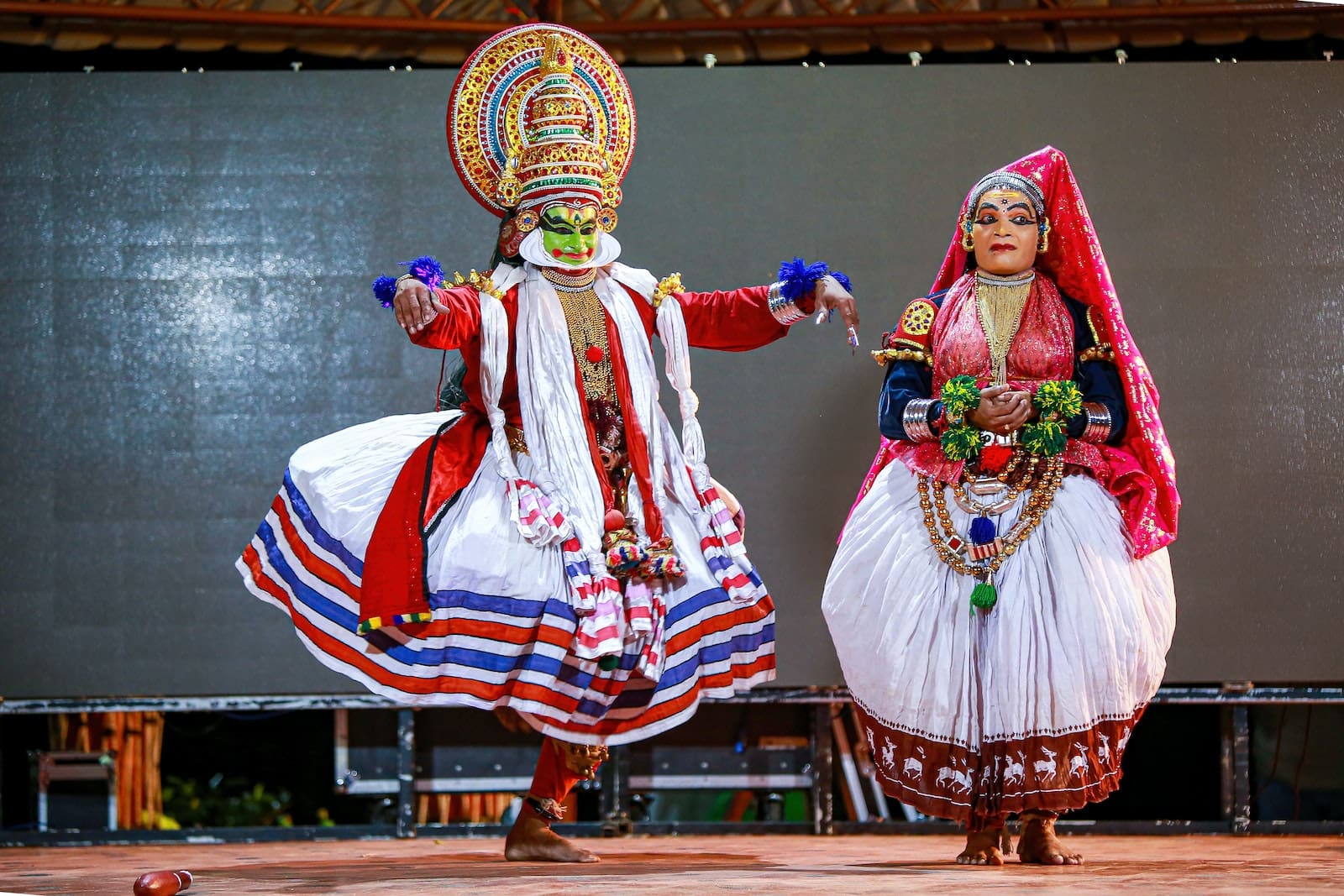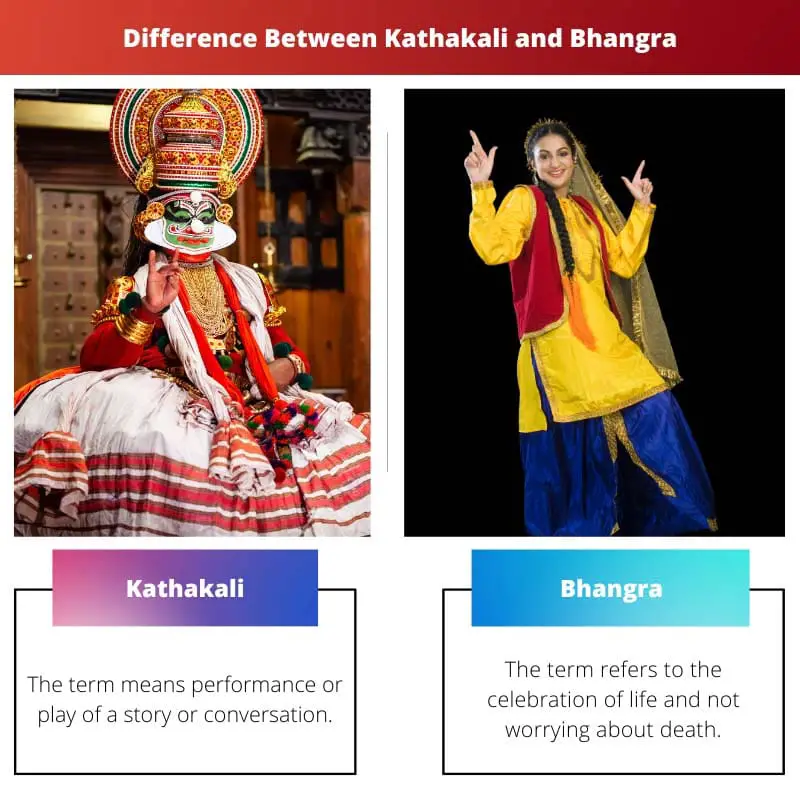Kathakali and Bhangra are both dance forms that have originated in India. The dance forms show how diverse the culture of India is.
Kathakali is a major form of classical dance which has originated in the state of Kerala. Bhangra is a folk dance that has its root in the state of Punjab.
Key Takeaways
- Kathakali is a classical Indian dance-drama from Kerala, while Bhangra is a Punjabi folk dance.
- Kathakali features elaborate makeup, costumes, and storytelling through expressive facial gestures and body movements, whereas high-energy movements and vibrant attire characterize Bhangra.
- Kathakali is performed in temples and theaters, while Bhangra is commonly performed during harvest festivals and celebrations.
Kathakali vs Bhangra
The difference between Kathakali and Bhangra is that while Kathakali is a classical dance that originated in Kerala and talks about various incidents and celebrates different stages of life, Bhangra, the dance form that originated in Punjab, celebrates the life and views one’s time on earth as a culmination of life and death and tells the viewers to embrace life and not worry about death.

Kathakali is a Malayalam term. It has its root in the state of Kerala, which is located in the south of India. It is a major form of classical dance and belongs to the “story play” genre of art.
One can recognise the dance form by the elaborately done makeup, which is very colourful.
Bhangra which is a Punjabi term has its root in the state of Punjab of India. It originated in the Sialkot area of Punjab. It is performed during the season of harvesting.
It is associated with the Vaishaki festival. This dance form has become the cultural representative of the state of Punjab.
Comparison Table
| Parameters of Comparison | Kathakali | Bhangra |
|---|---|---|
| Place of Origination | It originated in Kerala. | It originated in the Sialkot of Punjab. |
| Type of Dance | It is a classical dance form. | It is a folk dance form. |
| Time of Performance | It is performed during Onam, the annual festival of Kerala. | It is performed during the vernal Baisakhi festival. |
| Dress of dance | The dancers wear a saree or a long full skirt that reaches their ankles and jackets that are either purple, blue, yellow or red in colour. | The dancers wear salwar kameez but some dancers also wear lehenga choli or sharara. However, it is always accompanied by a paranda which is a tassel that is woven into the braid. |
| Meaning | The term means performance or play of a story or conversation. | The term refers to the celebration of life and not worrying about death. |
What is Kathakali?
Kathakali, which is Malayalam for story or performance play, is a major form of classical dance. Traditionally, it is performed by male actors who wear dace paints of various colours, the most common of which is green.
The roots of this dance are unclear. The style of Kathakali that is performed nowadays originated in the 17th century. This dance form, even though it is regarded as classical, originated from folk and temple dances.
The dance’s usual themes are folk stories, religious legends, or spiritual ideas taken from the Hindu epics or the Puranas.
The vocal performances are performed in Sanskritised Malayalam. Even though men are the only performers traditionally, nowadays, women are also included in the performance.
The dance is structured around plays called Attakatha, which literally translates to enacted stories composed in Sanskritised Malayalam.
The plays are written in such a way that they help the action and the dialogue part of the performance.
There are two parts, namely the Sloka, which is nothing but the metrical verse that is written in the third person that describes the choreography and the Pada part, which contains the dialogue part.
The stage is mostly kept empty other than a few drama-related ideas, and is never full of performers.

What is Bhangra?
Bhangra is a dance form that originated in the Sialkot area of Punjab and is performed by Punjabi farmers during the agricultural season.
Previously it was performed by farmers while doing chores. Doing the dance during chores enabled the farmers to finish their job in a pleasurable way.
It is related to the Punjabi dance form known as “Bagga”, which is a martial dance. Traditionally, it is performed in a circle. It has another form that is free from the constraints of traditional bhangra.
This form originated in the 1950s as Bhangra started garnering public attention. This was patronized by the Maharaja of Patiala.
Bhangra nowadays connects to a much deeper set of masculine values, which are set through labour self-sufficiency and are related to agriculture.
It also represents the values of loyalty, independence and bravery in personal and political contexts. Even though women were previously not included in this dance form, they nowadays use Bhangra as a means to connect with their culture.
With the increase in popularity of Punjabi culture in mainstream Indian media, Bhangra has become extremely popular and is shown as a popular means of expressing joy. It is hugely popular outside India and is used as a part of a fitness regime.

Main Differences Between Kathakali and Bhangra
- The language that Kathakali performs is Sanskritised Malayalam, while the language that Bhangra performs is in various dialects of Punjabi.
- Mostly the stage is bare during the performance of Kathakali, and the number of performers performing once at a time is not more than five, while many performers perform Bhangra at the same time.
- It tells various tales from Hindu mythology, while Bhangra talks about embracing life.
- Kathakali has not moved away from its traditional form, but Bhangra has various types that are different from the traditional form.
- The dress and makeup of Kathakali are elaborate, while that of Bhangra is quite simple and is associated with daily wear.

